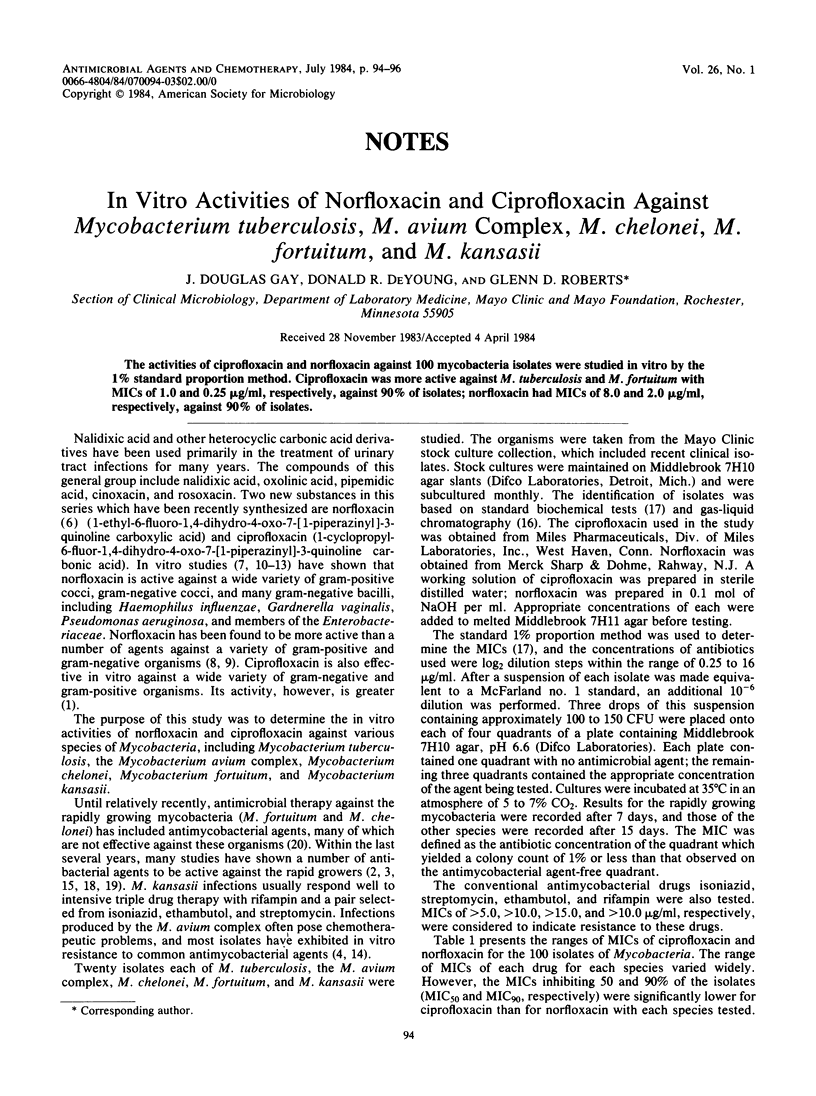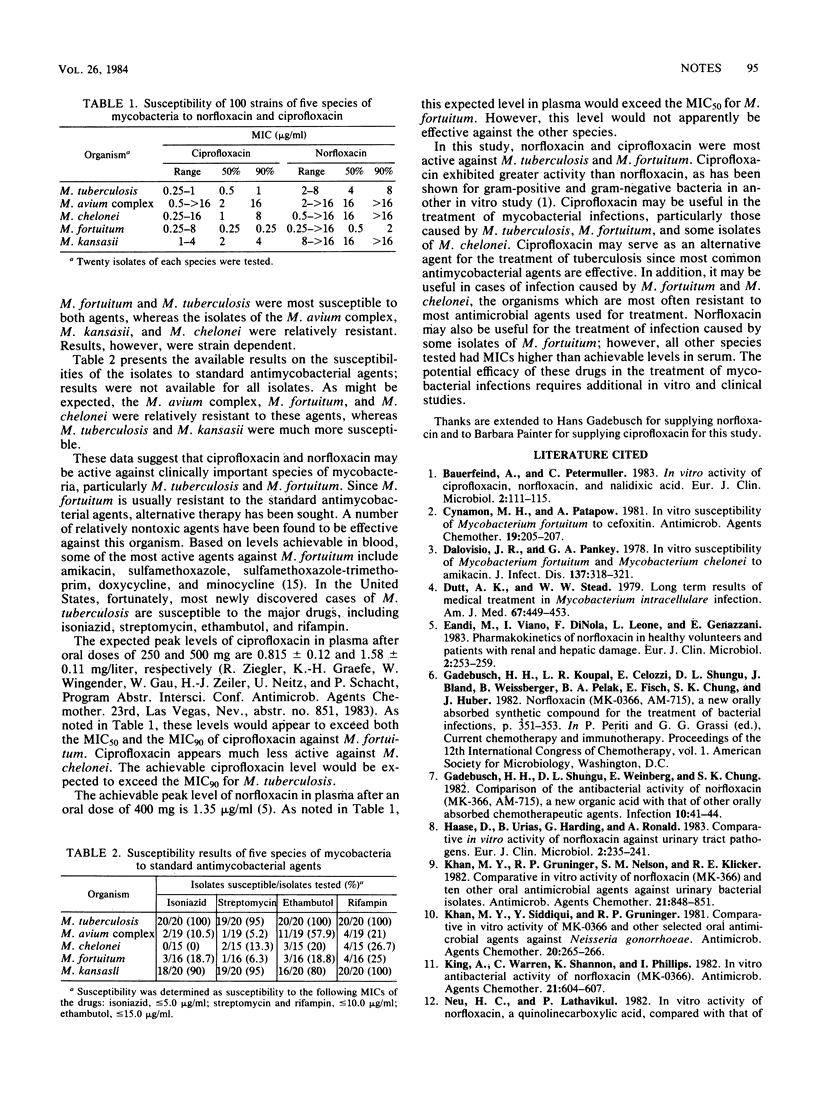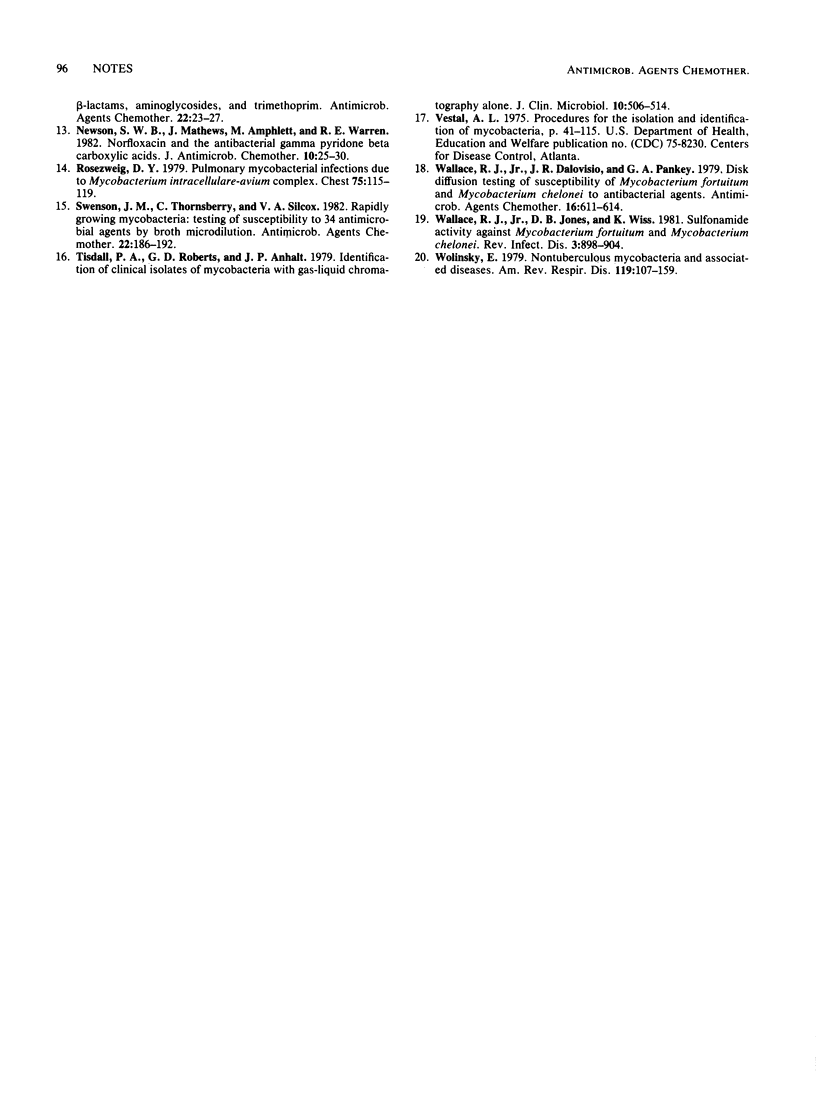Abstract
The activities of ciprofloxacin and norfloxacin against 100 mycobacteria isolates were studied in vitro by the 1% standard proportion method. Ciprofloxacin was more active against M. tuberculosis and M. fortuitum with MICs of 1.0 and 0.25 microgram/ml, respectively, against 90% of isolates; norfloxacin had MICs of 8.0 and 2.0 micrograms/ml, respectively, against 90% of isolates.
Full text
PDF


Selected References
These references are in PubMed. This may not be the complete list of references from this article.
- Bauernfeind A., Petermüller C. In vitro activity of ciprofloxacin, norfloxacin and nalidixic acid. Eur J Clin Microbiol. 1983 Apr;2(2):111–115. doi: 10.1007/BF02001575. [DOI] [PubMed] [Google Scholar]
- Cynamon M. H., Patapow A. In vitro susceptibility of Mycobacterium fortuitum to cefoxitin. Antimicrob Agents Chemother. 1981 Jan;19(1):205–207. doi: 10.1128/aac.19.1.205. [DOI] [PMC free article] [PubMed] [Google Scholar]
- Dalovisio J. R., Pankey G. A. In vitro susceptiiblity of Mycobacterium fortuitum and Mycobacterium chelonei to amikacin. J Infect Dis. 1978 Mar;137(3):318–321. doi: 10.1093/infdis/137.3.318. [DOI] [PubMed] [Google Scholar]
- Dutt A. K., Stead W. W. Long-term results of medical treatment in Mycobacterium intracellulare infection. Am J Med. 1979 Sep;67(3):449–453. doi: 10.1016/0002-9343(79)90792-7. [DOI] [PubMed] [Google Scholar]
- Eandi M., Viano I., Di Nola F., Leone L., Genazzani E. Pharmacokinetics of norfloxacin in healthy volunteers and patients with renal and hepatic damage. Eur J Clin Microbiol. 1983 Jun;2(3):253–259. doi: 10.1007/BF02029528. [DOI] [PubMed] [Google Scholar]
- Gadebusch H. H., Shungu D. L., Weinberg E., Chung S. K. Comparison of the antibacterial activity of norfloxacin (MK 0366, AM 715), a new organic acid, with that of other orally absorbed chemotherapeutic agents. Infection. 1982 Jan;10(1):41–44. doi: 10.1007/BF01640837. [DOI] [PubMed] [Google Scholar]
- Haase D., Urias B., Harding G., Ronald A. Comparative in vitro activity of norfloxacin against urinary tract pathogens. Eur J Clin Microbiol. 1983 Jun;2(3):235–241. doi: 10.1007/BF02029524. [DOI] [PubMed] [Google Scholar]
- Khan M. Y., Gruninger R. P., Nelson S. M., Klicker R. E. Comparative in vitro activity of norfloxacin (MK-0366) and ten other oral antimicrobial agents against urinary bacterial isolates. Antimicrob Agents Chemother. 1982 May;21(5):848–851. doi: 10.1128/aac.21.5.848. [DOI] [PMC free article] [PubMed] [Google Scholar]
- Khan M. Y., Siddiqui Y., Gruninger R. P. Comparative in vitro activity of Mk-0366 and other selected oral antimicrobial agents against Neisseria gonorrhoeae. Antimicrob Agents Chemother. 1981 Aug;20(2):265–266. doi: 10.1128/aac.20.2.265. [DOI] [PMC free article] [PubMed] [Google Scholar]
- King A., Warren C., Shannon K., Phillips I. In vitro antibacterial activity of norfloxacin (MK-0366). Antimicrob Agents Chemother. 1982 Apr;21(4):604–607. doi: 10.1128/aac.21.4.604. [DOI] [PMC free article] [PubMed] [Google Scholar]
- Newsom S. W., Matthews J., Amphlett M., Warren R. E. Norfloxacin and the antibacterial gamma pyridone beta carboxylic acids. J Antimicrob Chemother. 1982 Jul;10(1):25–30. doi: 10.1093/jac/10.1.25. [DOI] [PubMed] [Google Scholar]
- Rosenzweig D. Y. Pulmonary mycobacterial infections due to Mycobacterium intracellulare-avium complex. Clinical features and course in 100 consecutive cases. Chest. 1979 Feb;75(2):115–119. doi: 10.1378/chest.75.2.115. [DOI] [PubMed] [Google Scholar]
- Swenson J. M., Thornsberry C., Silcox V. A. Rapidly growing mycobacteria: testing of susceptibility to 34 antimicrobial agents by broth microdilution. Antimicrob Agents Chemother. 1982 Aug;22(2):186–192. doi: 10.1128/aac.22.2.186. [DOI] [PMC free article] [PubMed] [Google Scholar]
- Tisdall P. A., Roberts G. D., Anhalt J. P. Identification of clinical isolates of mycobacteria with gas-liquid chromatography alone. J Clin Microbiol. 1979 Oct;10(4):506–514. doi: 10.1128/jcm.10.4.506-514.1979. [DOI] [PMC free article] [PubMed] [Google Scholar]
- Wallace R. J., Jr, Dalovisio J. R., Pankey G. A. Disk diffusion testing of susceptibility of Mycobacterium fortuitum and Mycobacterium chelonei to antibacterial agents. Antimicrob Agents Chemother. 1979 Nov;16(5):611–614. doi: 10.1128/aac.16.5.611. [DOI] [PMC free article] [PubMed] [Google Scholar]
- Wallace R. J., Jr, Jones D. B., Wiss K. Sulfonamide activity against Mycobacterium fortuitum and Mycobacterium chelonei. Rev Infect Dis. 1981 Sep-Oct;3(5):898–904. doi: 10.1093/clinids/3.5.898. [DOI] [PubMed] [Google Scholar]
- Wolinsky E. Nontuberculous mycobacteria and associated diseases. Am Rev Respir Dis. 1979 Jan;119(1):107–159. doi: 10.1164/arrd.1979.119.1.107. [DOI] [PubMed] [Google Scholar]


